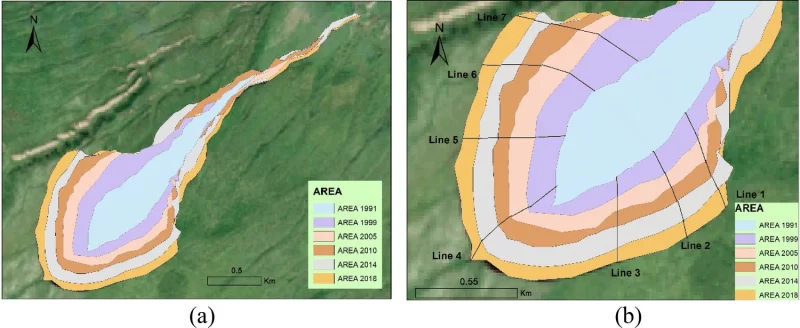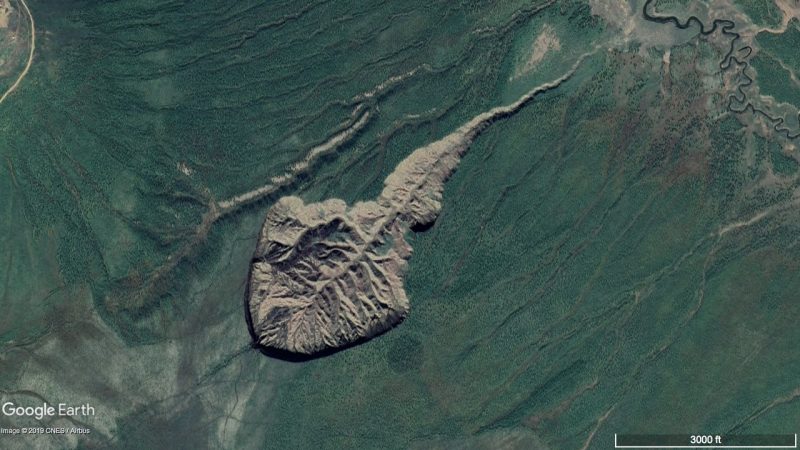The world’s biggest permafrost crater – called a mega-slump by scientists – started in the 1960s as a ravine.
World’s biggest permafrost crater
Newly captured aerial footage of the world’s biggest permafrost crater, Russia’s Batagaika Crater, has revealed never-before-seen details. The crater is located in the far eastern Siberian taiga (that is, boreal forest). It’s a rapidly growing 1-kilometer (0.6-mile) pit. Scientists call it a mega-slump. The expanding crater highlights rapid changes occurring even to Earth’s geology, as Earth’s climate changes in this century.
As reported by the London-based news service Reuters earlier this month (July 21, 2023), the crater first formed after the area was cleared for lumber in the 1960s. Now it’s expanding at a rate of about 10 meters (33 feet) per year. Reuters said:
[The crater] began to form after the surrounding forest was cleared in the 1960s. The permafrost underground began to melt, causing the land to sink.
Erel Stuchkov, one of the adventurous locals who braved a recent descent into the crater, said many of his neighbors refer to it simply as the cave-in. Others use the more ominous name gateway to the underworld.

Quickening cycle of permafrost collapse
Scientists have long known that the Arctic is warming faster than the rest of the globe. And this part of Russia – at some 67 degrees north latitude – is warming at a rate 2.5 times more quickly than the global average.
About 2/3 of the territory of the Russian Federation has been covered by a frozen tundra. In other words, it’s covered by permafrost – whose name comes from “permanent” and “frost” – now defined as ground that’s continuously below 0 degrees C (32 degrees F) for two or more years. Permafrost is known to store massive quantities of greenhouse gases. These gases are released to the air when the ground thaws.
Nikita Tananayev is lead researcher at the Melnikov Permafrost Institute. He issued a frightening warning about this ongoing human-made crisis to Reuters.
In future, with increasing temperatures and with higher anthropogenic pressure, we will see more and more of those mega-slumps forming, until all the permafrost is gone.
According to the USGS, dozens of similar collapsed areas already litter the Siberian landscape. Batagaika Crater is by far the largest, driven by a feedback loop of melting and collapsing.
And now it appears to be growing faster. The USGS explained:
This so-called “mega-slump” is being enlarged on a hillslope that leads down to the floodplain of the Batagay River. As the active soil slumps, more of the surrounding and underlying frozen soil is exposed and melts, causing the land to slump further and the extent and speed of the permafrost thawing to increase.
Based on satellite image records, the crater is expanding by more than 10 meters [33 feet] per year.
The USGS video below shows the crater’s striking growth from 1991 to 2017:
Affecting Earth’s climate and geology
So, Batagaika Crater is expanding about 10 meters (33 feet) per year. It’s hard to make that number precise, because the amount of variation changes from year to year.
Both the crater’s current size, and its potential impact on the environment, are enormous. Nikita Tananayev told Reuters that the soil beneath the slump, which is about 100 meters (328 feet) deep in some areas, contains an “enormous quantity” of organic carbon that will release into the atmosphere as the permafrost thaws.
This release of carbon will further fuel Earth’s warming.
Also, as it digs its way into the ground, the crater has so far exposed some 200,000 years sediments that record the planet’s climate history. A study of what the sediments reveal was published in 2017.
Geologist Trevor Nace, writing for Forbes at the time of the study’s publication, said that looking at Siberia’s environmental past can teach us about what lies ahead:
Measuring the sediment record at the crater will allow temperature and chronological records to be compared with ice sheets at the poles to regionally characterize warming and cooling periods.

Bottom line: New drone footage has revealed details of the world’s largest permafrost crater and its rapid growth.











